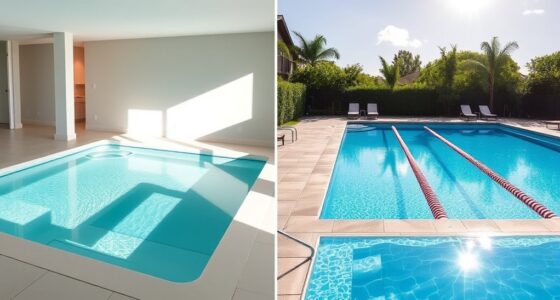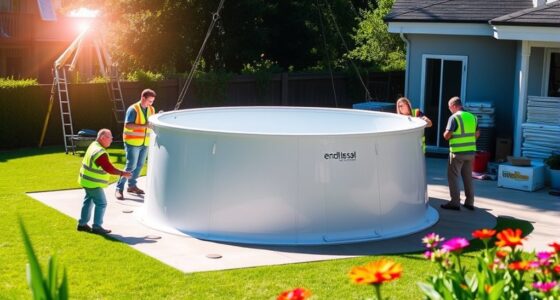To budget effectively for your endless pool, explore financing options like traditional loans, personal or home equity loans, and manufacturer offers. Watch out for hidden fees such as processing charges, prepayment penalties, or required insurance, which can add to your costs. Your credit score impacts interest rates, so improving it helps. Knowing the true cost involves understanding interest, repayment terms, and potential incentives—continue to discover how to make the smartest financial choice.
Key Takeaways
- Compare traditional loans, home equity loans, and manufacturer financing for the best interest rates and repayment terms.
- Watch out for hidden fees like processing, application, and early repayment penalties that can increase total costs.
- Check if manufacturer incentives or rebates have conditions that could affect overall savings.
- Improve your credit score to qualify for lower interest rates and better financing options.
- Review all loan details, including fixed or variable rates, to understand long-term costs before committing.
Exploring Traditional Loan Options for Endless Pools

When considering how to finance an endless pool, exploring traditional loan options is a practical first step. You can start by checking with banks or credit unions, which often offer personal or home improvement loans. These loans typically have fixed interest rates and predictable monthly payments, making budgeting easier. Before applying, review your credit score and financial stability, as these impact loan approval and interest rates. Comparing offers from multiple lenders helps you find the most favorable terms. Keep in mind that traditional loans usually require some documentation and a clear repayment plan. While they may involve fees or interest, they’re a straightforward way to secure funds for your pool without risking hidden costs. Understanding the loan approval process can help you better prepare your application and increase your chances of success. This approach provides a solid foundation to finance your backyard upgrade.
Understanding Personal and Home Equity Loans

After exploring traditional loan options, understanding personal and home equity loans can expand your financing choices for an endless pool. Personal loans are unsecured, meaning you don’t need collateral, but they often come with higher interest rates. Home equity loans, on the other hand, let you borrow against your home’s equity, usually offering lower interest rates and fixed payments. These loans can provide larger amounts and longer repayment terms, making them attractive options. However, they do put your home at risk if you default. Before proceeding, assess your financial stability and how much equity you have. Carefully compare interest rates, fees, and repayment plans. Choosing the right loan depends on your comfort level with debt and your overall budget. Additionally, consider the costs and risks associated with each option to ensure you make an informed decision.
Financing Through Pool Retailers and Manufacturers
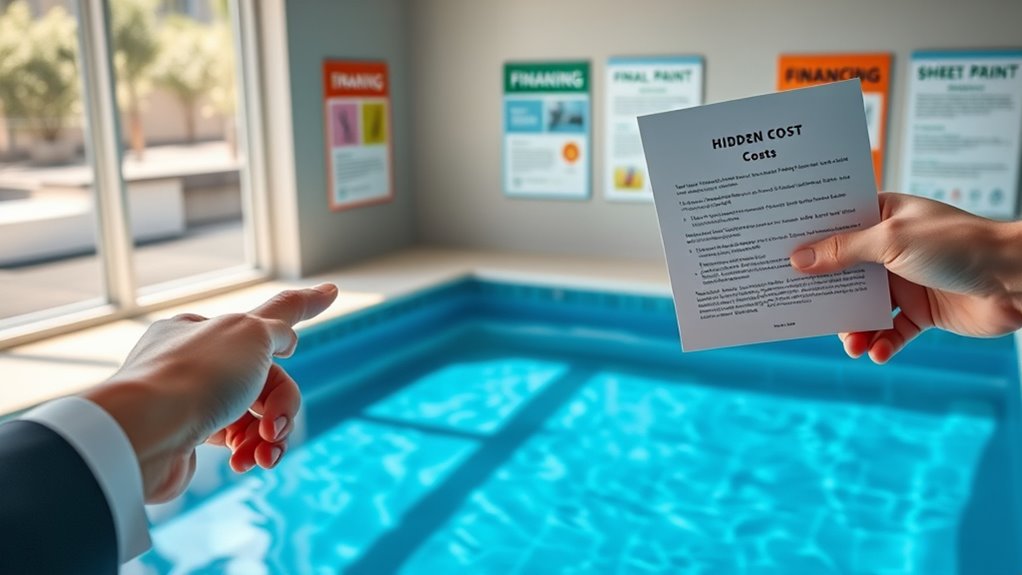
When financing through pool retailers and manufacturers, it is crucial to understand the loan terms and conditions upfront. Watch out for hidden fees and charges that can increase the overall cost, and always ask about any manufacturer incentives or rebates that could save you money. Being informed helps you make the best decision and avoid surprises down the line. Additionally, consider the interest rates and repayment options available, as these can significantly impact the total cost of your purchase.
Loan Terms and Conditions
Financing options through pool retailers and manufacturers often come with specific loan terms and conditions that you should carefully review. These agreements outline your repayment schedule, interest rates, and any applicable penalties for late payments or early payoff. It’s essential to understand whether the interest rate is fixed or variable, as a variable rate can increase over time, raising your costs. Also, check if there are any mandatory fees or minimum monthly payments that could strain your budget. Some lenders may impose restrictions on payment deferrals or require collateral. Reading the fine print helps you avoid surprises and ensures you know exactly what you’re agreeing to. Being informed about these terms allows you to make a smarter, more confident decision about financing your Endless Pool. Additionally, understanding how the contrast ratio and other image quality factors impact the overall value of a projector can help you select the best model within your budget.
Hidden Fees and Charges
While reviewing loan terms and conditions, it’s easy to focus on interest rates and repayment schedules. However, hidden fees and charges can catch you off guard if you’re not careful. When financing through pool retailers or manufacturers, watch out for processing fees, application fees, and early repayment penalties that aren’t immediately obvious. Some providers add mandatory insurance, extended warranties, or service plans that increase your overall cost. Others might include administrative or setup fees, which can considerably inflate your final bill. Always read the fine print and ask for a detailed breakdown of all potential charges. Failing to do so risks paying hidden costs that could make your pool more expensive than initially advertised. Staying informed about fraud prevention tools and understanding the fine print can help you avoid surprises that could strain your budget later.
Manufacturer Incentives and Rebates
Manufacturer incentives and rebates can considerably reduce the overall cost of financing your pool, but it’s important to understand how they work. These offers are typically provided directly by pool manufacturers to encourage sales and can include cash rebates, discounted equipment, or special financing rates. Sometimes, retailers pass these savings directly to you, lowering upfront costs. However, incentives can come with conditions, such as limited-time offers or specific purchase requirements. Always read the fine print, as some rebates may require you to fill out forms or meet certain criteria to qualify. While these incentives can make a pool more affordable, they shouldn’t be your sole focus. Ensure the pool’s quality, features, and long-term costs also align with your budget and needs. Understanding cost behavior analysis can help you evaluate how these incentives impact your overall expenses and budget planning.
Leasing vs. Buying: Which Is More Cost-Effective?
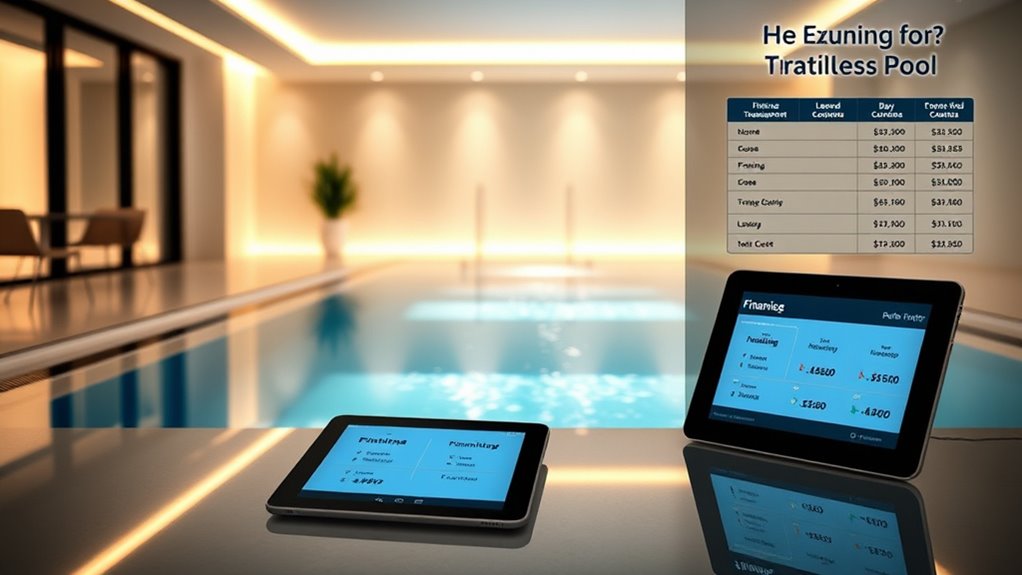
When deciding between leasing and buying, you’ll want to compare the upfront costs involved. Leasing often requires lower initial payments, while buying usually demands a larger down payment. Consider how each option impacts your long-term finances to determine which choice is more cost-effective for you.
Upfront Costs Comparison
Choosing between leasing and buying an endless pool primarily hinges on your upfront costs. Leasing typically requires a smaller initial payment, making it more accessible if you want to conserve cash. You might pay a deposit or initial fee, but these are usually lower than the full purchase price. Buying, on the other hand, demands a larger lump sum upfront or a significant down payment, which can strain your finances initially. The purchase price includes the pool itself and installation costs, which can add up quickly. If immediate cash flow is tight, leasing offers a way to get into a pool without a hefty upfront investment. Additionally, considering the quality and durability of the pool materials can influence long-term value and maintenance costs. However, buying may be more cost-effective over time, as you avoid ongoing lease payments and eventually own the asset outright.
Long-Term Financial Impact
While leasing may seem attractive initially due to lower upfront costs, buying often proves more economical in the long run. When you purchase an Endless Pool, you pay upfront or finance it, building equity over time. After years of ownership, you own the equipment outright, eliminating ongoing payments. Leasing, on the other hand, involves continuous monthly fees without ownership, which can add up considerably over time. Plus, lease agreements often include restrictions on usage or customization. If you plan to keep your pool long-term, buying typically results in lower total costs and greater flexibility. You avoid recurring fees and can potentially resell the pool later. Additionally, understanding the security features of your financing options can help protect your investment. Ultimately, buying offers a better long-term financial impact, especially if you value ownership and ongoing cost savings.
The Role of Credit Scores in Pool Financing

Your credit score plays a crucial role in determining your pool financing options. A higher score shows lenders you’re responsible with debt, making you more likely to qualify for better loan terms and lower interest rates. If your score is excellent, you could secure a loan with minimal fees and flexible repayment options. Conversely, a lower score might limit your choices or lead to higher interest rates, increasing your overall costs. Some lenders may require a larger down payment or impose stricter borrowing conditions if your credit isn’t strong. Before applying, check your credit report for errors and work on improving your score if needed. Understanding your credit standing helps you navigate the financing process more effectively and ensures you find the best possible deal for your pool. Additionally, credit scores can influence the types of loan options available to you, so maintaining a good score can open up more favorable financing opportunities.
Hidden Fees and Additional Expenses to Watch For

Even though the advertised financing terms may seem straightforward, there are often hidden fees and extra expenses that can substantially increase the total cost of your pool. Origination fees, late payment charges, and prepayment penalties are common pitfalls lenders don’t always highlight. Additionally, some agreements include mandatory insurance or service plans that add to your monthly costs. Be wary of application fees or processing charges that can surprise you at closing. Maintenance costs, delivery fees, and optional upgrades may also be bundled into your financing agreement, increasing your overall expense. Always read the fine print carefully and ask your lender about any potential hidden charges. Staying informed about additional costs such as delivery fees or optional upgrades can help you make a more accurate budget and avoid unwelcome surprises down the line.
Calculating the True Cost: Interest Rates and Payment Terms
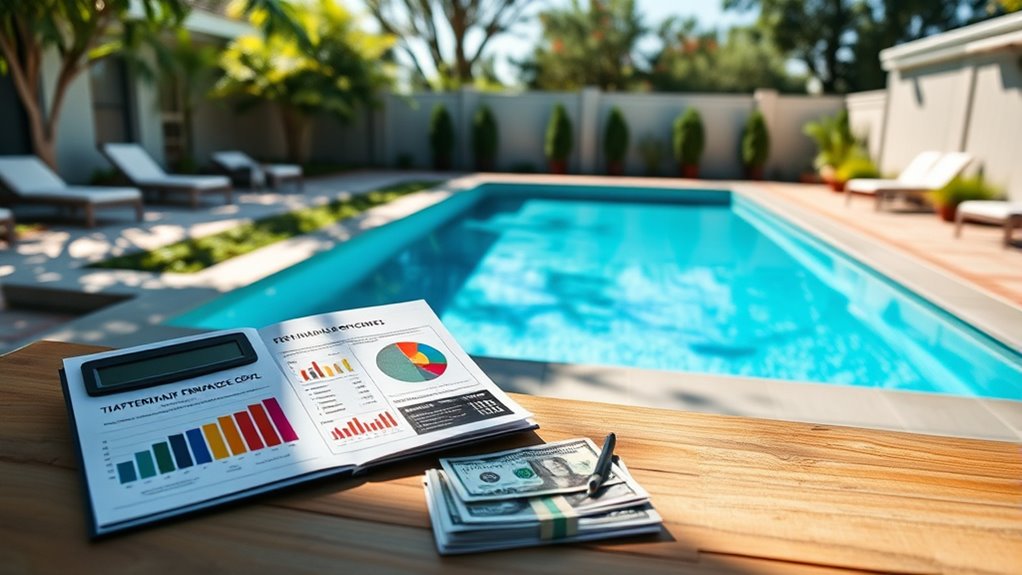
Understanding the true cost of your pool involves more than just the sticker price; it requires a careful look at interest rates and payment terms. Interest rates determine how much you’ll pay over the life of the loan, so a seemingly small difference can add up considerably. Fixed rates offer predictable payments, while variable rates can fluctuate, potentially increasing your costs. Payment terms—like the loan duration—also impact your total expenses and monthly budget. Longer terms lower monthly payments but increase overall interest paid. Shorter terms mean higher monthly costs but less interest overall. Carefully compare offers, paying attention to the annual percentage rate (APR) and repayment schedules, so you can accurately estimate what you’ll pay in the long run. This helps you avoid surprises and choose the best financing option for your budget.
Tips for Securing the Best Financing Deals

Finding the best financing deal for your endless pool starts with shopping around and comparing offers. Don’t settle for the first option—look at different lenders, terms, and interest rates. Check for prepayment penalties or hidden fees that may increase your costs later. Improve your chances by boosting your credit score before applying; a higher score often means better rates. Consider fixed-rate loans for predictable payments or promotional offers from manufacturers. Always read the fine print to understand all costs involved. Negotiate with lenders—sometimes they’ll match or beat competitor offers. Finally, stay patient and thorough; rushing into a deal may lead to overlooked expenses or unfavorable terms. Taking these steps helps you secure a financing deal that fits your budget and long-term financial health.
Frequently Asked Questions
Are There Government Grants or Subsidies Available for Pool Purchases?
Yes, you might qualify for government grants or subsidies when purchasing a pool, especially if you’re installing it for health, accessibility, or environmental reasons. Check local, state, or federal programs that support home improvements or health initiatives. Keep in mind, eligibility criteria vary, and application processes can be competitive. Research thoroughly and consult relevant agencies to see if you qualify for financial assistance, making your pool purchase more affordable.
How Do Seasonal Promotions Impact Pool Financing Terms?
Seasonal promotions can markedly improve your pool financing terms by offering lower interest rates, reduced down payments, or deferred payments. During peak seasons, dealerships often provide these deals to attract buyers, so you might secure better financing options if you act quickly. Keep an eye out for limited-time offers, and remember to read the fine print to avoid hidden costs. Timing your purchase around these promotions can save you money and improve your overall financing experience.
Can I Combine Multiple Financing Options for Better Rates?
Yes, you can combine multiple financing options to get better rates, but it depends on the lenders involved. You should compare terms carefully, ensuring each option’s benefits align with your budget. Be cautious of potential hidden costs or penalties for refinancing or switching plans. Always read the fine print and speak with a financial advisor if needed to maximize your savings and avoid unexpected expenses.
What Are the Long-Term Financial Implications of Leasing Versus Buying?
Buying an Endless Pool usually means paying upfront or financing with a loan, giving you ownership and potential equity benefits over time. Leasing, on the other hand, often involves lower monthly payments but no ownership, which might lead to higher costs long-term if you decide to keep the pool. Consider your financial stability and long-term plans; buying often benefits you financially in the long run, while leasing offers flexibility.
How Does Inflation Affect the Cost of Pool Financing Over Time?
Ever notice how your pool financing costs seem to creep up? Inflation directly impacts these costs over time by eroding purchasing power, which can lead to higher interest rates or increased monthly payments on new loans. If inflation rises, you might find that the actual cost of your pool financing increases, making it more expensive than initially planned. Staying aware of inflation helps you better anticipate and manage these rising expenses.
Conclusion
Remember, exploring all financing options helps you avoid hidden costs. For example, a homeowner who chose a low-interest personal loan saved thousands compared to a high-interest retailer lease. Always compare interest rates, payment terms, and potential fees. By doing your homework, you’ll find the best deal and guarantee your endless pool fits comfortably into your budget. Don’t rush—smart financing makes enjoying your pool worry-free and affordable.


